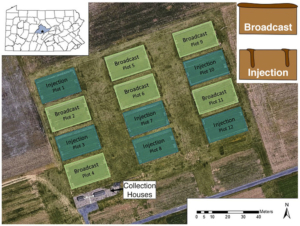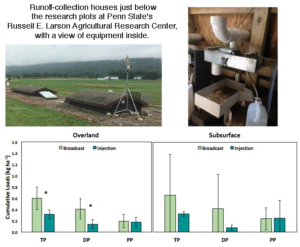
Credit: Penn State
Scientists have long sought ways to help reduce nutrient pollution to the Chesapeake Bay from agricultural lands, particularly in Pennsylvania. To test different methods of manure application, researchers from Pennsylvania State University (PSU) compared plots with manure injected into the soil with plots where manure was broadcasted over the soil to compare phosphorous runoff. This research is published in Agriculture, Ecosystems and Environment.

The 12 research plots at Penn State’s Russell E. Larson Agricultural Research Center. Credit: Jack Watson Research Group/Penn State
The team, including graduate student Melissa Miller and P.I. Jack Watson, among others, measured overland and subsurface water flows, phosphorous, and solids during and after precipitation events from 12 plots over 4 years. Six of the plots had manure injected into the soil, and the other six had manure broadcasted over the top. They looked at total phosphorous loads, phosphorous in the water, phosphorous attached to sediments (particulate phosphorous), and total solids in the water coming off the plots. They found that the injection method was an effective way of reducing dissolved phosphorous while not increasing runoff of particulate phosphorous.
One surprising finding was that plots with manure injection did not have increased sedimentation compared to broadcast sites, even in heavy rainfall. Many farmers have adopted “no till” practices to prevent dislodged sediments from washing into the Chesapeake Bay, but manure sitting on top often washes away instead, leading to nutrient pollution. Not only did injection not lead to more sedimentation, it led to lower phosphorous flows overall. The challenge now will be to communicate these findings to farmers and no-till advocates.
It is difficult to quantify the effects of phosphorous treatments because of hydrologic variability on different sites. For example, Watson noted that injection would be “more helpful on slope sites than on level sites because on level sites you don’t have a lot of [nutrient] losses anyway.” In addition, Pennsylvania soils are often rocky, which can damage expensive injection equipment. These variables may make it difficult to implement and complicated to explain to farmers.

Bar graphs featured in their paper. Pictures show how runoff was collected from the research plots.
One other challenge to advocating for manure injection is that researchers are not sure how it will impact nitrogen. Another graduate student at Penn State is currently looking into this, but Watson expects different results from the phosphorous study. “Normally nitrogen is more of a concern for groundwater, so our expectation is that the injection procedure is not going to work as well for nitrogen losses as it does for phosphorous losses.”
Although past studies have compared dissolved phosphorous concentrations in broadcast and injection sites, Miller took an innovative approach by thinking like a hydrologist. She wanted to know if higher precipitation would lead to more phosphorous in the runoff, or if the extra water would dilute it. She found that manure injection did not lead to more phosphorous leaving the site in any form, meaning that it was diluted by the extra precipitation. Typically, phosphorous concentrations are measured in the soil using a Mehlich-3 soil extractant. In this study, however, concentrations of phosphorous in the soil were not a good predictor of phosphorous losses in the runoff, meaning the hydrology of the site mattered more to predicting losses than phosphorous concentrations in the soil.
This study has big implications for water quality in the Chesapeake Bay. “[These results] will allow farmers to be confident that they’re able to continue no-till practices will using manure injection as a practice to reduce dissolved phosphorous into the Chesapeake Bay,” explained Watson. He added, “we really feel like these things can live in harmony. The particulate phosphorous from the surface runoff of injected sites was not more than from broadcast sites. And that’s really what landowners are trying to prevent: sediments moving off site.”
